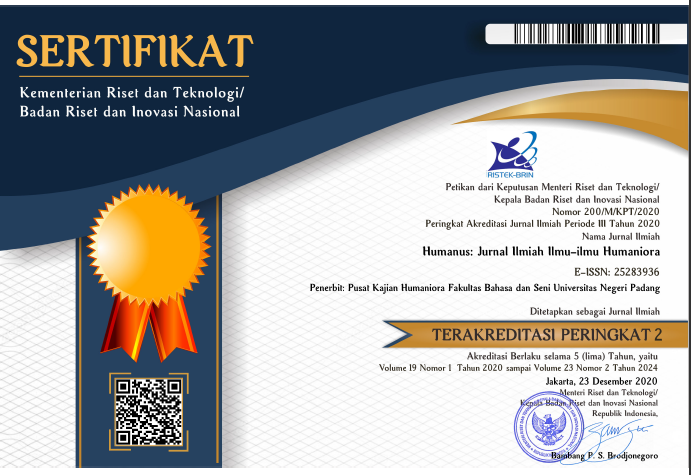THE PHENOMENA OF SPLIT-S AND FLUID-S IN MINANGKABAUNESE: A Grammatical-Typological Study
 ),
), (1) FBS Universitas Negeri Padang
 Corresponding Author
Corresponding Author
Copyright (c) 2017 Humanus
DOI : https://doi.org/10.24036/jh.v15i2.6512
Full Text:
 Language : en
Language : en
Abstract
Minangkabaunese, a local language originally spoken by Minangkabaunese in West-Sumatera, has been typologically assigned as a nominative-accusative language (S = A, ≠ P) at syntactical level. Further typological studies on grammatical constructions, however, indicate that there are constructions which can be classified as the ergative-absolutive ones in this language. Thus, Minangkabaunese belongs to a neutral language, then. As a neutral language, it is assumed that this language has the constructions so called split-S and fluid-S. This paper, typologically discusses the grammatical properties of split-S and fluid-S in Minangkabaunese. The idea of this paper is derived and further developed based on a part of the research result conducted in 2013-2014. The data presented and discussed in this article were collected through a descriptive-qualitative research in the form the field research and library study. The analysis was based on the relevant theories of grammatical typology. The result of analysis tells that Minangkabaunese has the grammatical constructions which can be assigned as split-S and fluid-S. This typological discussion may add grammatical data and typological information into analyses on linguistic typology.
Key word: Minangkabaunese, accusative, absoultive, split-S, fluid-S
Keywords
References
Anderson, J. M. 1976. ‘On the Notion of Subject in Ergative Languages’ in Li, C. N. (ed.) Subject and Topic, pp.1 – 23. New York: Academic Press.
Artawa, I Kt. 2004. Balinese Language: a typological description. Denpasar: C.V. Bali Medika Adhikarsa.
Artawa, I Kt. 2005.”Tipologi Bahasa dan Komunikasi Lintas Budaya” (scientific oration). Denpasar: Universitas Udayana.
Comrie, Bernard. 1983. 1989. Language Universals and Linguistic Typology. Oxford: Basil Blackwell Publisher Limited.
Croft, William. 1993. Typology and Universals. Cambridge: Cambridge University Press.
Dixon, R. W. M. 1994. Ergativity. Cambridge: Cambridge University Press.
Jufrizal. 2004. ‘Struktur Argumen and Aliansi Gramatikal Bahasa Minangkabau’ (doctoral dissertation). Denpasar. Program Pascasarjana Universitas Udayana.
Jufrizal. 2012. Tatabahasa Bahasa Minangkabau: Deskripsi dan Telaah Tipologi Linguistik. Padang: Universitas Negeri Padang Press.
Jufrizal., Jufri., and Zul Amri. 2012. ‘Keakusatifan dan Keergatifan Bahasa Minangkabau: Telaah Tipologi Linguistik dan Budaya Berbahasa’ (unpublished research report). Padang: Fakultas Bahasa dan Seni Universitas Negeri Padang.
Jufrizal., Zaim, M., and Ardi, Havid. 2013, 2014. ‘Bahasa dan Budaya Minangkabau: Dari Tipologi Linguistik ke Budaya Berbahasa Penuturnya’ (unpublished research report). Padang: Universitas Negeri Padang.
Mallinso, Graham., and Blake, Barry J. 1981. Language Typology: Cross-Linguistic Studies in Syntax. Amsterdam: North-Holland Publishing Company.
Newmeyer, Frederick J. (ed.). 1990. Linguistics: The Cambridge Survey. Cambridge: Cambridge University Press.
Payne, T. E. 2002. Describing Morphosyntax: A Guide for Field Linguists. Cambridge: Cambridge University Press.
Song, J.J. 2001. Linguistic Typology: Morphology and Syntax. Harlow, England: Pearson Education Limited.
Whaley, L. J. 1997. Introduction to Typology. London: SAGE Publication.
 Article Metrics
Article Metrics
 Abstract Views : 422 times
Abstract Views : 422 times
 PDF Downloaded : 116 times
PDF Downloaded : 116 times
Refbacks
- There are currently no refbacks.
Copyright (c) 2017 Humanus

This work is licensed under a Creative Commons Attribution-NonCommercial 4.0 International License.









